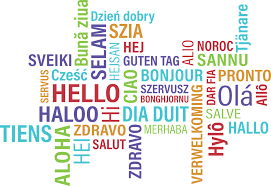There are roughly 7,000 spoken languages across the world, with different dialects and varying structures that can be rigid, fluid, expressive, or restrictive depending on the language being spoken. The ability to communicate complex thoughts and ideas to one another can sometimes be taken for granted, as learning a new language later in life can be extremely difficult. Depending on the language being spoken, it can either be easy to express one’s self or it can be restraining. Taking into consideration these different avenues of speech, one has to wonder if the language we speak could influence the way we think.
Stanford University cognitive scientist Lera Boroditsky is one of the world’s leading contributors to the theory of Language Relativity. This theory is separated into two views, the strong view and the weak view. The strong states that the structure of language determines thought and can even affect the speaker’s world view on certain topics and ethical issues. The weak states that the structure of language only influences action and thought. This leads to the question that if we believe our language and the way we speak influences our actions and thoughts, where do bilinguals and multilinguals fall on this controversial issue?
Learning a secondary language can be extremely difficult at first. Karen Maqueda, junior early childhood education major with a focus as an intervention specialist, has some thoughts.
“There’s an initial difficult stage of translating everything in your head to your first language, and then having to translate it back again into your secondary language when trying to communicate with others, which can be awkward or take awhile,” she said about learning a new language later in life. “But once you get past that stage, you’re thinking in that second language all the time. It’s more fluid and natural.”
When asked how she felt about the structure of the English language versus the structure of the Spanish language, Maqueda stated, “I feel more like my true self when I speak Spanish. It’s more personal to me. I feel like I can express myself easily in Spanish, and one of the hardest things to learn about English was the conjugate verbs as well as trying to translate simultaneously while trying to talk to others. Sometimes people would make fun of me, which made the whole process even more stressful.”
Maqueda said that there are some phrases in Spanish that she loved but were hard to express in English. “In Spanish, we have two ways to say ‘I love you,'” she said. “Te quiero is a love that you can feel for almost anyone around you. Te amo is a deeper love. The kind of love that couples have and that you see surrounding families.”
Asian Thappa, junior music major, is originally from Brunei in Southeast Asia. Thappa has been learning English ever since he was in kindergarten, where his father, a former teacher, would often speak to him and his older brother while they were growing up. Along with speaking English, Thappa also speaks Hindi and Nepali.
“The only time I would speak Nepali was at home with my friends and family,” he said. “Whenever I was at school I always spoke English with my friends, so both were easy to remember.”
Thappa said that he associated certain emotions with different languages, such as frustration in the form of cursing. “When I curse it’s usually in English,” he said. “I guess that’s because it’s more colorful that way. Not so much in Nepali. I feel like I can express more in English. I feel like in Nepali there aren’t a whole lot of verbal expressions of emotion, it’s more of statements of action. But in English there are a lot more of those verbal expressions for what one is feeling.”
“Whenever something is really important to me I’ll speak in Nepali, because it’s my native language and very deep rooted. Sometimes I’ll use English as a way of desensitizing something,” Thappa said.
Thappa said that his favorite Nepali phrase is “Namaste.”
“It means, ‘I bow to the God within you,’ and is used to greet people or to say goodbye,” he said.
Kookily Varadarajan, first-year biology pre-med major from India, has been speaking English ever since she was young. She also speaks Hindi and Tamil.
“When I experience dynamic emotions such as anger or excitement, I don’t really stick to one language. I use all three of my languages interchangeably,” she said. “If I get angry at someone for doing something ridiculous, I may curse in Tamil such as calling them ‘Naie,’ or Hindi with ‘buddhu,’ or English with ‘dummy.’”
“However, I usually think in English. In India, English is considered the go-to language in the professional sphere. Most of the schools in India are usually English – medium schools. So in schools we almost always communicated with the teachers in English, as well as wrote our exams and other assignments in English as well,” Varadarajan said.

